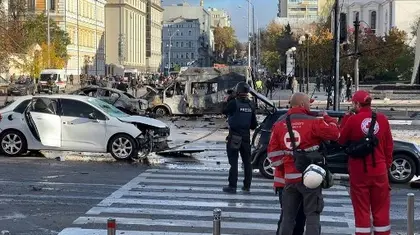The Kremlin on Monday launched a brutal wave of missile and kamikaze drone strikes blasting dozens of civilian targets, along with a few military structures, across Ukraine.
The capital Kyiv was pounded by at least six missiles and the urban centers of Dnipro, Zaporizhziia, Kryvyi Rih, Odesa, Ivano-Frankivsk, Khmelnitskyi, Ternopil, Lviv and Zhytomyr also were hit.
JOIN US ON TELEGRAM
Follow our coverage of the war on the @Kyivpost_official.
At least three waves of cruise missiles detonated across the country between 8 a.m. and 10 a.m., during morning rush hour. The attacks came two days after a spectacular Ukrainian strike against the logistically-critical Kerch Strait bridge, connecting Russia-occupied Crimean peninsula with the Russian mainland.
Valery Zaluzhny, commander of the Armed Forces of Ukraine (AFU), in a statement said that Russia fired at least 75 cruise missiles in the morning strikes, of which the AFU units shot down 41. As of 11 a.m., the attacks were continuing, he said.
Russian state media had widely called for Russian President Putin to retaliate with direct and devastating attacks on Ukrainian cities and infrastructure in response to the Kerch Bridge strike.
In Kyiv, an initial wave of at least four missiles struck the center of the city. One blew up in the government quarter near Maidan Square, the scene of mass demonstrations in 2014 against a fraudulent election that – temporarily – made a pro-Kremlin candidate Ukraine’s president. Another missile hit the adjacent Pechersk district, blowing out windows of a high-rise office building used by President Volodymyr Zelensky’s staff and other top members of the national government executive branch.

Erdogan to Pitch Plan at G20 to Freeze War, Postpone Ukraine’s NATO Bid
One missile hit Kyiv’s upmarket Golden Gate district, next to the National Academy of Sciences building. The strike took place during morning rush hour. Images from the scene showed a burning automobile and a demolished statue of 20th century Ukrainian scientist Myhailo Hrushevsky.
Less than a block away from the intersection where one of the missiles launched at Kyiv landed, a Kyiv Post correspondent spoke to a sacristan at St. Volodymyr’s Cathedral, who preferred not to give his name. “The blast wave broke the window above the entry, but as you see, we’ve already cleaned it up and the liturgy is being celebrated.”
Most of the buildings around the intersection are part of Taras Shevchenko National University.
Kyiv City Clinical Hospital No. 18, which is located about 50 meters from the intersection that was hit, had all its windows broken.
The Museum of Natural History, the National Opera, and St. Volodymyr’s Cathedral are all located within a block of the intersection.
Multiple videos showed an explosion underneath a pedestrian bridge in Volodymyrska Hirka park, a popular leafy space with park benches and sidewalks overlooking the Dnipro River.
In a video recorded outdoors less than a kilometer from at least two of the missile impact sites, President Zelensky said: “We are dealing with terrorists…they are trying to cause panic and chaos, they want to destroy our power grid. They are hopeless.”
Ukrainian Defense Minister Oleksii Reznikov was defiant: “Our courage will never be destroyed by terrorists’ missiles, even when they hit the heart of our capital…the only thing they demolish is the future of Russia, a future of a globally despised rogue terrorist state.”
Kyiv mayor Vitaly Klitschko in a Telegram statement said the strikes killed and injured civilians and that emergency response teams were on the scene. Early casualty reports ranged from five to eight persons killed and as many as 25 injured.
Traffic disappeared from the capital’s streets as most of Kyiv residents took to bomb shelters or metro stations for safety. Images from across the city showed craters or damage in a kindergarten playground.
Oleksandr Tkachenko, Ukraine’s Minister of Culture, said the capital’s Philharmonic Orchestra building and two national museums were damaged in the blasts. Images made public by Zelensky’s office showed smoke rising from at least two strikes near a Kyiv city power station.
The southern city of Zaporizhzhia was heavily hit with a reported ten weapons striking civilian homes and businesses. Oleksandr Starukh, head of the Zaporizhzhia regional defense command in a statement said that part of an apartment building had been completely destroyed. Russian missiles hit the city overnight on the Oct. 9, killing 14 and injuring 70.
An Oct. 6 strike on the industrial center killed 19 and wounded 49. Foreign Minister Dmytro Kuleba in a weekend statement called on western nations to give Ukraine more air defense weapons “to save innocent lives.”
In Lviv region, two missiles reportedly landed on Monday morning near the village of Berezdivtsy. Regional spokesman Maksym Kozitsky said the Kremlin strikes targeted power grid infrastructure. In Lviv, Khmelnytskyi and Zhytomyr power was reportedly lost across most of the cities.
In Dnipro, images showed the roof of a military vehicle repair facility burning and badly damaged by a missile strike. According to unconfirmed reports, at least five explosions were heard in the vicinity.
According to Ukraine’s national air defense information network, during Monday morning Russia launched missiles at Ukrainian targets from six airfields. Vitaly Kim, head of the Mykolaiv regional defense command, said the Russian military was also firing missiles from airfields in Russia’s Astrakhan region. The third wave alone, launched at around 9:30 a.m., contained 47 missiles, he said.
Other unconfirmed reports said that Russia used submarines and bombers to launch missiles in the morning attacks.
You can also highlight the text and press Ctrl + Enter






